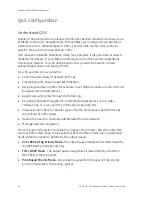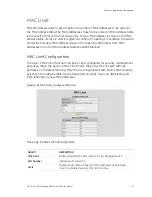
Chapter 4: Web-Based Management
110
GE-DS-242-PoE Managed Ethernet Switch User Manual
Client-the device (workstation) that requests access to the LAN and switch services
and responds to requests from the switch. The workstation must be running 802.1X-
compliant client software such as that offered in the Microsoft Windows XP operating
system. (The client is the supplicant in the IEEE 802.1X specification.)
•
Authentication server -
performs the actual authentication of the client. The
authentication server validates the identity of the client and notifies the switch
whether or not the client is authorized to access the LAN and switch services.
Because the switch acts as the proxy, the authentication service is transparent to
the client. In this release, the Remote Authentication Dial-In User Service (RADIUS)
security system with Extensible Authentication Protocol (EAP) extensions is the
only supported authentication server; it is available in Cisco Secure Access Control
Server version 3.0. RADIUS operates in a client/server model in which secure
authentication information is exchanged between the RADIUS server and one or
more RADIUS clients.
•
Switch (802.1X device) -
controls the physical access to the network based on the
authentication status of the client. The switch acts as an intermediary (proxy)
between the client and the authentication server, requesting identity information
from the client, verifying that information with the authentication server, and
relaying a response to the client. The switch includes the RADIUS client, which is
responsible for encapsulating and decapsulating the Extensible Authentication
Protocol (EAP) frames and interacting with the authentication server. When the
switch receives EAPOL frames and relays them to the authentication server, the
Ethernet header is stripped and the remaining EAP frame is re-encapsulated in
the RADIUS format. The EAP frames are not modified or examined during
encapsulation, and the authentication server must support EAP within the native
frame format. When the switch receives frames from the authentication server,
the server's frame header is removed, leaving the EAP frame, which is then
encapsulated for Ethernet and sent to the client.
•
Authentication Initiation and Message Exchange
The switch or the client can initiate authentication. If you enable authentication on a
port by using the dot1x port-control auto interface configuration command, the
switch must initiate authentication when it determines that the port link state
transitions from down to up. It then sends an EAP-request/identity frame to the client
to request its identity (typically, the switch sends an initial identity/request frame
followed by one or more requests for authentication information). Upon receipt of the
frame, the client responds with an EAP-response/identity frame.
However, if during bootup, the client does not receive an EAP-request/identity frame
from the switch, the client can initiate authentication by sending an EAPOL-start
frame, which prompts the switch to request the client's identity.
Summary of Contents for GE-DS-242-POE
Page 1: ...GE Security P N 1069174 REV 1 0 ISS 22FEB10 GE DS 242 PoE Managed Ethernet Switch User Manual ...
Page 14: ...Chapter 1 Introduction 10 GE DS 242 PoE Managed Ethernet Switch User Manual ...
Page 124: ...Chapter 4 Web Based Management 120 GE DS 242 PoE Managed Ethernet Switch User Manual ...
Page 130: ...Chapter 5 Console Management 126 GE DS 242 PoE Managed Ethernet Switch User Manual ...
Page 204: ...Chapter 8 Power Over Ethernet Overview 200 GE DS 242 PoE Managed Ethernet Switch User Manual ...
Page 210: ......















































